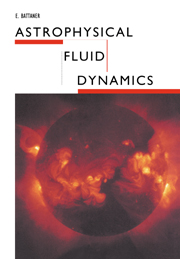Book contents
5 - THE FLUID IN A STAR
Published online by Cambridge University Press: 05 June 2012
Summary
This chapter is organized as follows: first, three basic types of star are studied in some detail: main-sequence stars, white dwarfs, and black holes; other transient and related types are then discussed more descriptively, classified according to the parameters mass and time.
Main-sequence stars
Main-sequence stars or normal stars are self-gravitating bodies, in hydrostatic equilibrium, consisting of hydrogen, helium, and other minor constituents, in a physical state that can reasonably be described as that of an ideal gas, releasing nuclear energy from the fusion of hydrogen to helium.
The mass loss in the fusion process 4H → He is very large; some 0.7% of the rest mass is converted to radiative and kinetic energy. If the star were pure hydrogen, the fusion of hydrogen could supply energy of 0.001 Mc2, where M is the star's mass. Other fusion processes are much less effective. Atoms heavier than iron cannot be produced by exothermic fusion reactions. A hypothetical process 14 He → Fe would have a mass loss of only 0.1%, supplying only approximately O.OO1Mc2. Hydrogen is thus the major fuel constituent and the most energetic nuclear process is 4H → He. After leaving the main sequence other heavier nuclei are produced, but the energy available is less and the post-main-sequence period is short. Before nuclear burning, a star radiates for a short time due to gravitational contraction. As the largest fraction of the energy is released during the main-sequence epoch, this will be the longest lasting stellar phase.
- Type
- Chapter
- Information
- Astrophysical Fluid Dynamics , pp. 101 - 132Publisher: Cambridge University PressPrint publication year: 1996

